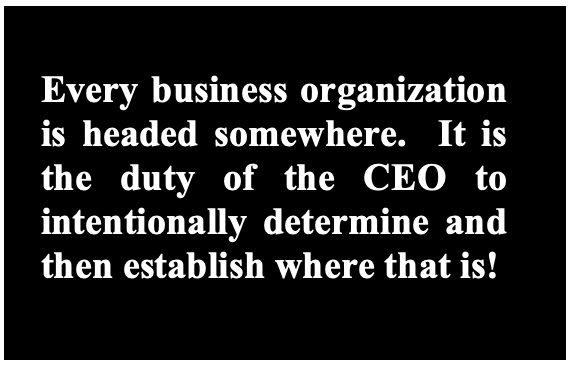 Strategic management is a full-time occupation. Although, sometimes we get so busy working in our business we forget to actually steer the course. One of my favorite analogies for business is a sailing ship. The skipper must constantly steer and measure the boat’s progress toward its destination. Based upon measurements of wind, heading and progress, the skipper makes adjustments to optimize progress toward the destination. It is exactly the same with a business! The Role of the CEO is to steer toward the destination as well. These can include weekly, monthly, quarterly and annual goals or objectives. Many of the business’s activities can be measured and coordinated to achieve these goals. Otherwise, the business is wasting time and money as it heads off course. And, trust me, it will head off course fairly quickly. Steering from point to point or, “Management by Objective”, is critical unless profits and value are not important to you. “Management by the Seat of Your Pants”; just reacting and coming up with tasks that seem like good ideas and implementing them is a terrible way to manage.
Strategic management is a full-time occupation. Although, sometimes we get so busy working in our business we forget to actually steer the course. One of my favorite analogies for business is a sailing ship. The skipper must constantly steer and measure the boat’s progress toward its destination. Based upon measurements of wind, heading and progress, the skipper makes adjustments to optimize progress toward the destination. It is exactly the same with a business! The Role of the CEO is to steer toward the destination as well. These can include weekly, monthly, quarterly and annual goals or objectives. Many of the business’s activities can be measured and coordinated to achieve these goals. Otherwise, the business is wasting time and money as it heads off course. And, trust me, it will head off course fairly quickly. Steering from point to point or, “Management by Objective”, is critical unless profits and value are not important to you. “Management by the Seat of Your Pants”; just reacting and coming up with tasks that seem like good ideas and implementing them is a terrible way to manage.
This missive is not by any means intended to be an over-arching treatise on all that the CEO should be. Nor is it intended to be a complete job description. It is simply to serve as a reminder to the entrenched CEO/Owner to pick their head up out of the day-to-day business and steer the ship.
Best Practices
Establish a leadership team
It might not always seem obvious, but one of the primary concerns of a CEO is to develop a business that will run optimally without them on a daily basis. This means establishing and mentoring a team of managers who can lead the company without daily interference by the CEO. They must not only be qualified as individuals, but also have trust and respect for each other. If this group proves unsure of itself or does not work well together, then you may have the wrong people in the seats. Developing this group is an ongoing task.
Establish corporate vision
Every business organization is headed somewhere. It is the duty of the CEO to intentionally determine and then establish where that is! The CEO needs to determine where the company should be three to ten years down the road. This vision should be specific with regard to revenues, geography, process, as well as competitive and market position.
Set goals
As Yogi Berra might say: “If you don’t know where you are going, it’s hard to get there”. It is critical that your business has realistic and achievable objectives to steer for on a monthly, quarterly and annual basis. These goals should be filtered through not only the Leadership Team, but also the Company’s values and its long-term vision. Communicating these goals, as well as each employee’s role in achieving them, is part of how a company achieves focused alignment. Goals should address the strategic areas of sales, marketing, customer experience, financial and leadership development.
Establish accountability
A goal without accountability for its achievement it is more often than not, a waste of paper. Every goal/objective should be quantified in a measurable way with a firm date for its achievement. As importantly, each goal deserves a champion who will ultimately be responsible for its achievement.
Measure progress weekly
The leadership team should meet weekly to measure progress toward its monthly and quarterly goals, resolve problems and address opportunities.
Solve problems
As an organization is making its way toward realizing its goals, it will encounter obstacles and frustrations. It is imperative that the Leadership Team have a system in place to identify these problems/obstacles and resolve them weekly.
Celebrate progress and achievements
Make no mistake, highlighting and celebrating even the little successes can help make all of the difference in keeping a team motivated and on task. Acknowledge those who go above and beyond and give others the power to do the same.
As a new business reaches a certain size and begins to stabilize, the role of the CEO necessarily changes from worker, technician, marketer to that of a mentor who facilitates and guides other managers to keep all of the plates spinning, with one eye on the goal.
Burke Advisory Services
November 2019
Kevin Burke is a member of the Turnaround Management Association and a Certified Turnaround Professional. A graduate of the Villanova School of Business, he has over 35 years of experience in banking and executive management. His management consulting practice is located in Troy, Michigan.
